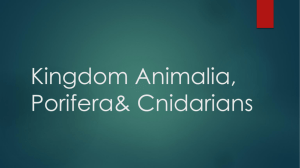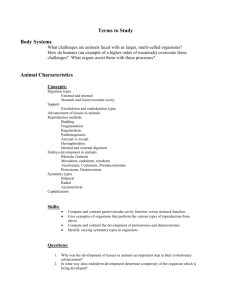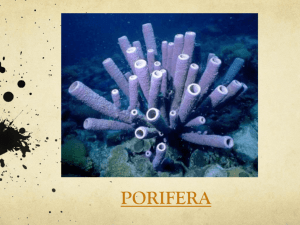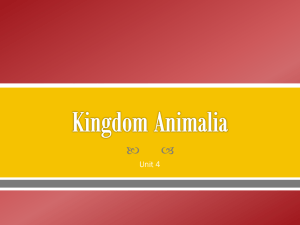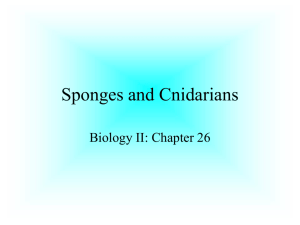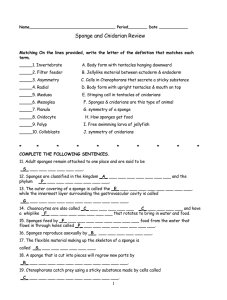Sponge_and_Cnidarians
advertisement
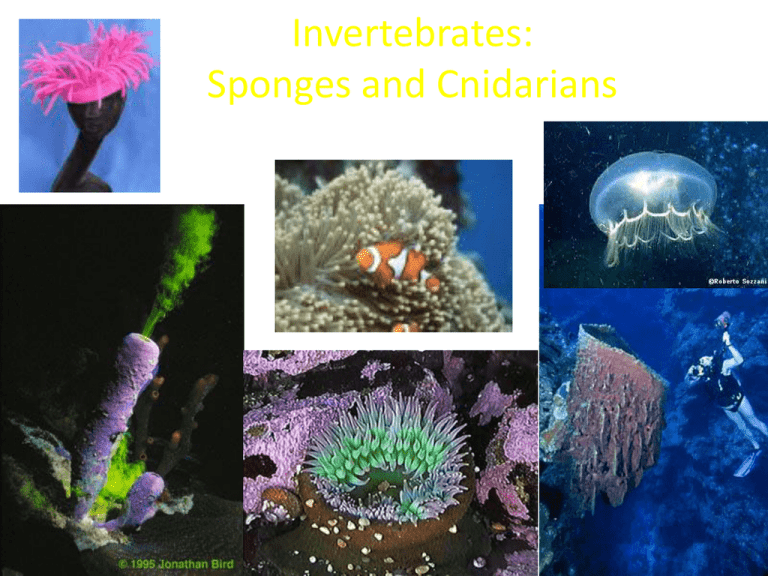
Invertebrates: Sponges and Cnidarians Sponges: • • • • • • • • • Phylum Porifera means- pore bearer Simplest of all animals Assymetrical animals that live in shallow waters Sessile filter-feeders whose bodies have many pores Acoelomates-no body cavity Obtain oxygen by filtering water Uses: cleaning, bathing, cosmetics No nervous system or organ systems Sponge Reproduction • Reproduce Asexually by budding: • Buds form from sides of parent sponge, bud break off and grow into new individual identical to the parent • can grow back missing parts (regeneration) • Reproduce sexually: • Hermaphrodites: produce both eggs and sperm • Gametes are released into water Sponge Reproduction • Many are asexual: branches or buds break off and grow into separate sponges identical to the original one. * No Sound * Sponge Reproduction • Sexually: When both sexes release gametes during the spawning season. Spawning Sponge Reproduction • Most sponges can produce both male and female gametes in the same individual and is called monoecious • Some are dioecious meaning that they have separate sexes in each individual (either male OR female…not both) Are we monoecious or dioecious? Sponge Reproduction • Once the egg is fertilized, a larva is formed • Larva: Is an immature stage that may undergo a dramatic change in structure before changing to the adult body form • After no more than 2 days of free-swimming existence, the larva settles to the substrate and begins to develop into the adult form What is “Substrate”? Sponge Body Structures: • Osculum: large opening at the top of the sponge • Pore cells (Ostia): openings to bring in water • Collar cells (choanocytes): line interior, have flagella to help filter water • Spicules: hard, supportive structures found in body of sponge Porifera: Anatomy • Water leaves through the osculum, a large opening on the top Choanocytes (Collar Cells) • Food is trapped here. Porifera: Eating • After choanocytes trap food on their collar, and is moved along to the base of the collar • Food is then engulfed by the cell to form a food vacuole, and is digested by enzymes and pH changes • Digested food is passed to amoeboid cells, & distributes it to other cells The Anatomy of a Sponge Section 26-2 Osculum Central cavity Pores Water flow Choanocyte Spicule Pore cell Pore Epidermal cell Archaeocyte Commercial Importance • Bath Sponges: Harvested & used to bathe with • Medical: Some act as antibiotics & others have painkilling properties (still researching) Cnidarians: • Phylum Cnidaria: means “stinging cell” • Marine • Radial symmetry • Have tentacles • Predators: capture and poison prey with stinging cells on tentacles (NEMATOCYST) • Acoelomates • Oxygen diffuses into body from water Cnidarian Body Forms • Polyp: body with tentacles hanging upward • Ex: hydra, sea anemone • Medusa: body with tentacles hanging downward • Ex: jellyfish Cnidarian Reproduction: • Asexually reproduce by budding • Sexually reproduce in medusa form only, sperm and eggs are released into water • Thousands of gametes are released at a time Time to Think! Why do sponges and cnidarians release so many gametes into the water? The body plan of an animal relates to its complexity. What does that tell you about sponges and Cnidarians since they are both acoelomates? Cnidarian Structures: • Basal disc: sticky end of polyp form which allows them to stay in one spot • One body opening (mouth) for food to enter and wastes to exit • Gastrovascular cavity: interior cavity where food is digested & nutrients are circulated around the body • Nerve net: net of nerves that allow impulses to travel around the body, senses the environment • Muscles: some muscles are present; allows for some movement Three groups of cnidarians • Hydrozoans: colonies which appear to be one organism • Ex: portugese-man-of-war • Scyphorozoans: independent medusas • Ex: jellyfish, box jellies • Anthozoans: colonies of polyps • Ex: corals, sea anemones Quiz 1. Sponges __ animals. a. are b. are not 2. Sponges can reproduce asexually by ___. a. budding b. regeneration c. both 3. Hydras have their tentacles pointing upwards. They are __. a. medusas b. nematocysts c. polyps 4. All cnidarians have ___ symmetry. a. bilateral b. radial c. no symmetry 5. Cnidarians poison their prey with stinging cells called ___. a. choanocytes b.nematocysts c. osculum


